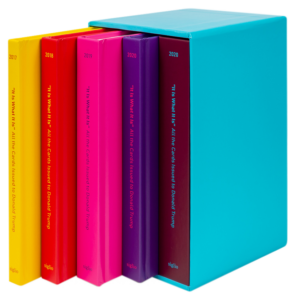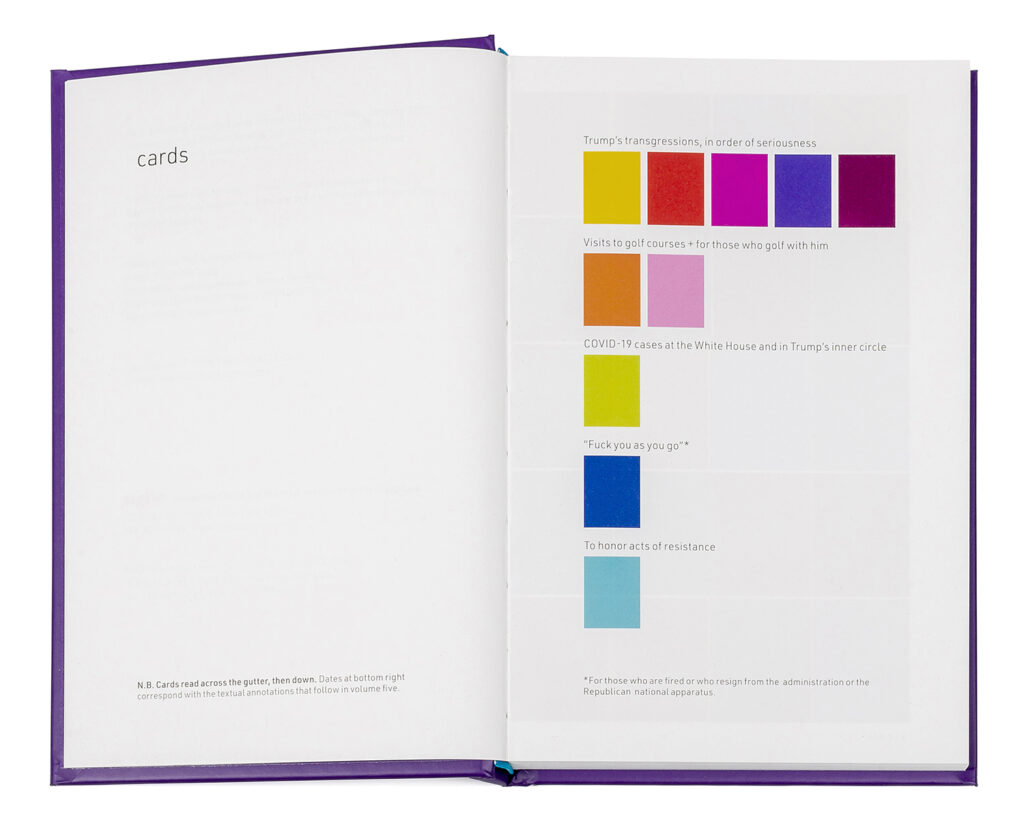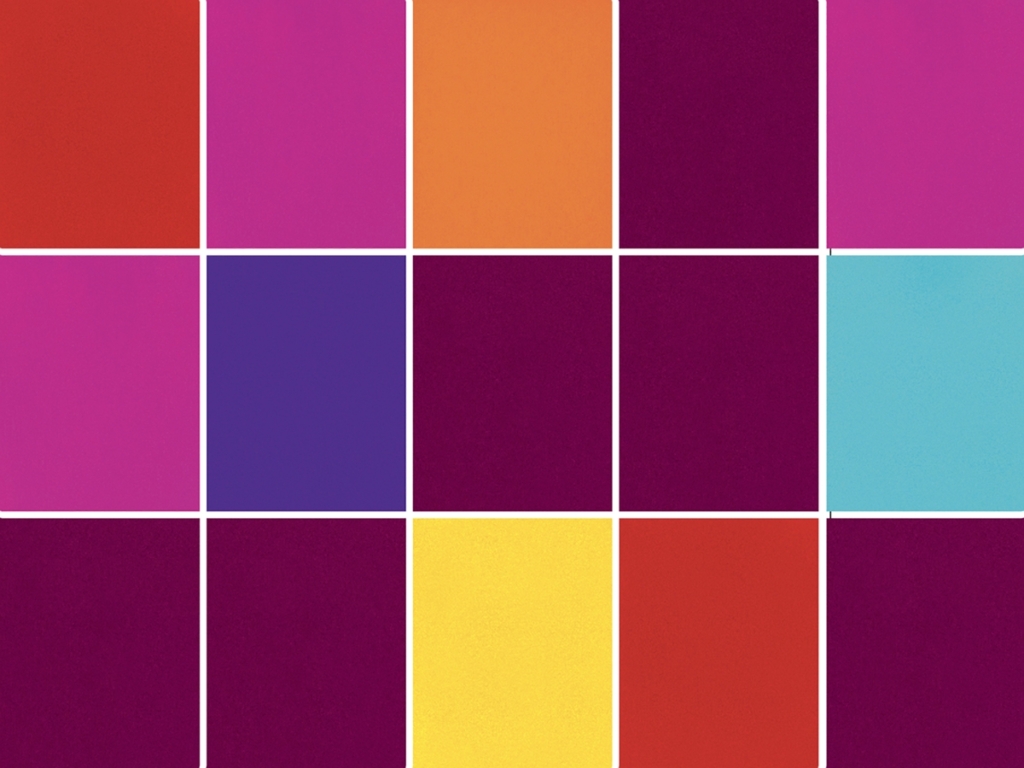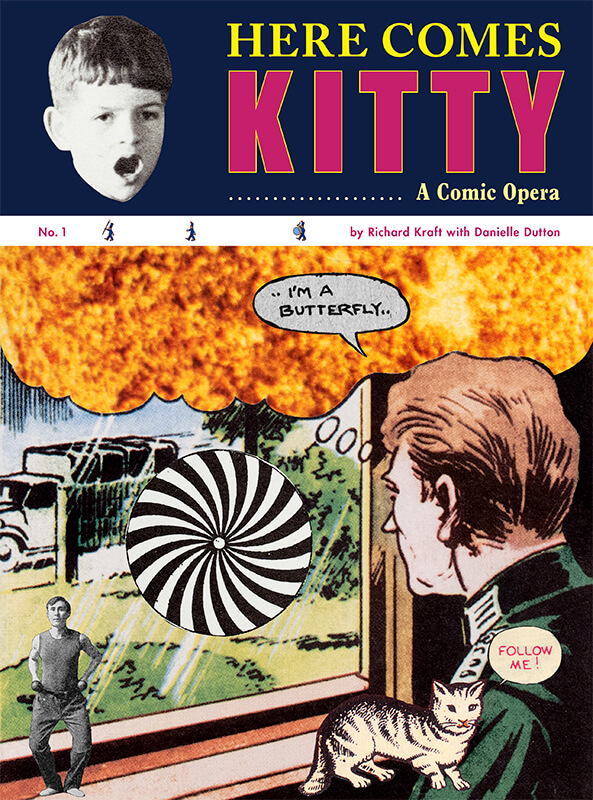“It Is What It Is”All the Cards Issued to Donald Trump, January 2017–January 2021
Richard Kraft

slipcased set of 5 hardback books, each 5.25 × 8.25 in.
1622 pages total, all color
978-1-938221-28-6
published in 2021
edition of 650
15% of sales go to organizations on the front lines of voting rights! We’ve donated $4500 in total so far to Native American Rights Fund and Four Directions.
Heat maps of proto-fascism as if realized by Ellsworth Kelly.
—Louis Bury, Hyperallergic
On inauguration day January 20, 2017, artist Richard Kraft began issuing Donald Trump penalty cards, just as a soccer referee wields a yellow as a caution and a red for dismissal. For four years, Kraft scoured the news and Trump’s Twitter feed every day, notating and assigning each of Trump’s offenses a colored card (at first yellow and red, then Kraft devised magenta, purple, and crimson as the offenses became more egregious). Through January 20, 2021, when Trump presidency came to an end, Kraft recorded almost 10,000 offenses, each assigned a card and annotated in the corresponding color.

In this set of five artist’s books, totaling over 1600 pages, the ever-mutating, accumulating grids of colored cards reveal the frequency, chronology, and intensity of Trump’s transgressions. In their beauty and abstraction, they evoke musical notation, abstract painting, the processing of digital information, or geologic strata. Conversely, the textual annotations, totaling over 500,000 words, written as neutrally as possible, precisely describe each violation. The annotations become a shocking chronicle, a kind of day-to-day — sometimes minute-by-minute — account that leaves no doubt about the intentions of this president from his first day in office through January 6, 2020.
This project is many things—a marriage of outrage with absurdity, of vigilance with futility; a durational work of art and work of great endurance; an experiment to turn toxicity into beauty; a daily reckoning and a bulwark against forgetting. “It Is What It Is” originates in the artist’s refusal—to normalize the Trump presidency, to become complacent or inured, to never turn away from the ugliness. Now, as a critical election looms, “It Is What It Is” is something else as well: a cautionary tale of epic proportions.
In the Brooklyn Rail, critic Leah Ollman writes a lucid essay that details the project while interpreting it. Her assessment: “Kraft heaps toxic muck into a formal vehicle of exceeding elegance and grace. His stance is both scathing and playful, his aesthetic at once stark and lush. All of this generative friction makes for an engrossing experience. Not just the eye, and not just the intellect, not just the heart, not just the hand, and not just the conscience—all at once are engaged, pressured, provoked.”
read, listen, see
read Kraft’s introductory essay as well as interviews by Steve Heller at The Daily Heller, Louis Bury at Hyperallergic, and Aaron Robertson at Lit Hub; find an excerpt at Design Observer of both cards and texts for January 6, 2020; listen to Laura Kuhn’s interview on All Things Cage/WGXC about Cage’s influence on Kraft’s work; and see the video conversation between Mónica de la Torre and Kraft at the Brooklyn Rail’s New Social Environment.
about the author
RICHARD KRAFT is a British born artist whose multidisciplinary works engage many spheres of inquiry (language, literature, history, and popular culture) and incorporate a variety of media (film, collage, photography, drawing, and performance). This diversity of interests and methods is united in acts of alteration and transformation of the everyday world, and in the exploration of simultaneity, multiplicity and indeterminacy. Kraft is the recipient of a 2021 Guggenheim Fellowship and the author of the artist’s book Here Comes Kitty: A Comic Opera and co-editor of John Cage’s Diary: How to Improve the World (You Will Only Make Matter Worse), Marcel Broodthaers: My Ogre Book, Shadow Theater, Midnight, and Felix Gonzalez-Torres: Photostats. He also hosts the podcast Acts & Facts, interviewing people about eight talismanic books.
press
On the page, the mosaics of jewel-toned rectangles in richly designed spreads look like soothing abstractions, but the transgressions underlying each hue transform the effect, jolting the mind out of the visual pleasure they provide.
—Fran Bigman, Bookforum
There’s something weirdly haunting about Kraft’s record with its manic determination and regularity. Flipping through these thousands of colored cards, like an elemental cartoon, is both baffling and horrific.
—Ron Charles, Washington Post
see also
✼ elsewhere:
“The truth is that I operate as a writer and in some ways as an editor very much inside a space of instinct. There’s a kind of silence there …” —Danielle Dutton, from her interview with Karla Kelsey in Feminist Poetics of the Archive at Tupelo Quarterly
[...]
